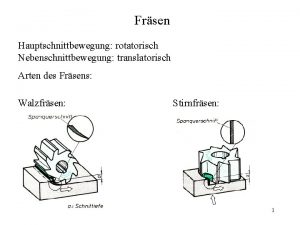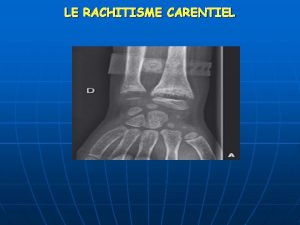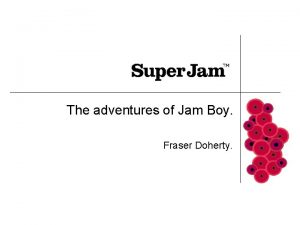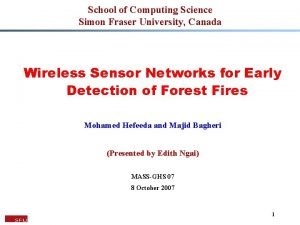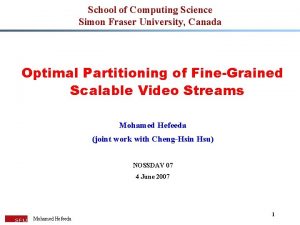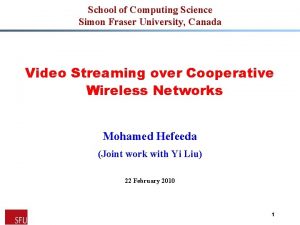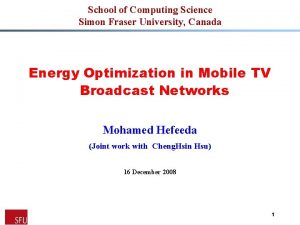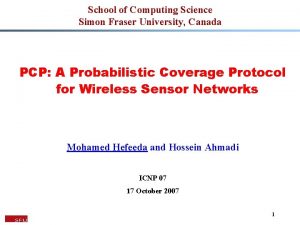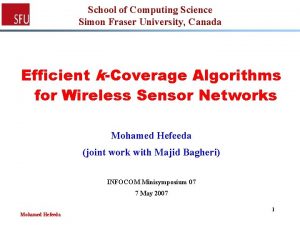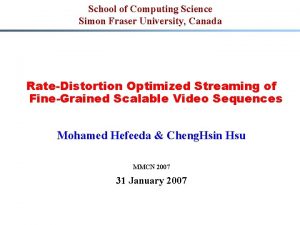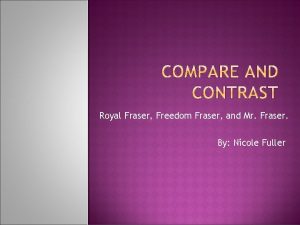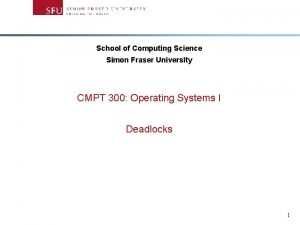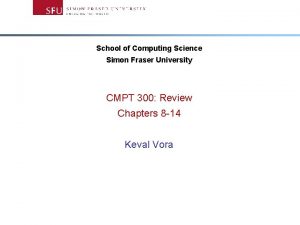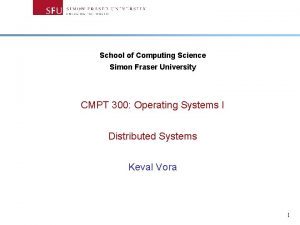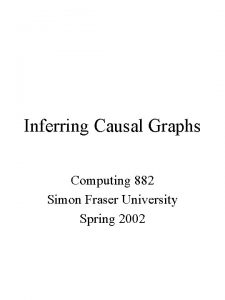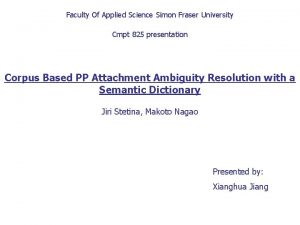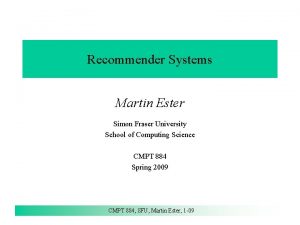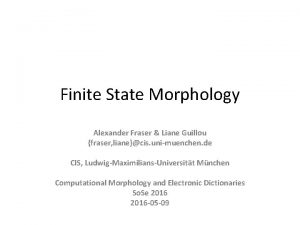School of Computing Science Simon Fraser University Canada

























- Slides: 25

School of Computing Science Simon Fraser University, Canada Modeling and Caching of P 2 P Traffic Mohamed Hefeeda Osama Saleh ICNP’ 06 15 November 2006

Motivations § P 2 P traffic is a major fraction of Internet traffic § … and it is increasing [Karagiannis 04] § Negative consequences - increased load on networks - higher cost on ISPs (and users!), and - more congestion § Can traffic caching help ? 2

Our Problem § Design an effective caching scheme for P 2 P traffic § Main objective: - Reduce WAN traffic reduce cost & congestion 3

Our Solution Approach § Measure and model P 2 P traffic characteristics relevant to caching, i. e. , - seen by cache deployed in an autonomous systems (AS) § Then, develop a caching algorithm 4

Why not use Web/Video Caching Algorithms? § Different traffic characteristics: - P 2 P vs. Web: P 2 P objects are large, immutable and have different popularity models - P 2 P vs. Video: P 2 P objects do not impose any timing constraints § Different caching objectives: - Web: minimize latency, make users happy - Video: minimize start-up delay, latency and enhance quality - P 2 P: minimize bandwidth consumption

Related Work § Several P 2 P measurement studies, e. g. , - [Gummadi 03]: Object popularity is not Zipf, but no closed-form model is given, conducted in one network domain - [Klemm 04]: Query popularity follows mixture of two Zipf distributions, we use popularity of actual object transfers - [Leibowitz 02] [Karagiannis 04]: highlight potential of caching P 2 P traffic, no caching algorithms presented - All provide useful insights, but they were not explicitly designed to study caching P 2 P traffic § P 2 P caching algorithms - [Wierzbicki 04]: proposed two P 2 P caching algorithms, we compare against the best of them (LSB) - We also compare against LRU, LFU, and GDS 6

Measurement Study § Modified Limewire (Gnutella) to: - Run in super peer mode - Maintain up to 500 concurrent connections (70% with other super nodes - Log all query and queryhit messages § Measure and model - Object popularity - Popularity dynamics - Object sizes § Why Gnutella? - Supports passive measurements - Open source: easy to modify - One of the top-three most popular protocols [Zhao 06] 7

Measurement Study: Stats Measurement Period Jan 06 – Sep 06 Unique Objects 17 M Unique IPs 39 M ASes with more than 100, 000 downloads Total traffic volume 127 6, 262 Tera Bytes § Is it representative for P 2 P traffic? We believe so. - Traffic characteristics are similar in different P 2 P systems • [Gummadi 03]: Non-Zipf traffic in Kazza, same as ours • [Saroiu 03]: Napster and Gnutella have similar session duration, host up time, #files shared • [Pouwelse 04]: Similar host up time and object properties in Bit. Torrent

Measurement Study: Object Popularity Notice the flattened head, unlike Zipf 9

Modeling Object Popularity § We propose a Mandelbrot-Zipf (MZipf) model for P 2 P object popularity: - α: skewness factor, same as Zipf-like distributions - q: plateau factor, controls the plateau shape (flattened head) near the lowest ranked objects - Larger q values more flattened head § Validation across top 20 ASes (in terms of traffic) - Sample in previous slide

Zipf vs. Mandelbrot-Zipf § Zipf over-estimates popularity of objects at lowest ranks Zipf § Which are the good candidates for caching AS 18538

Effect of MZipf on Caching (HZipf - HMZipf) / HZipf • Simple analysis using LFU policy • Significant bye hit rate loss at realistic cache sizes (e. g. , 10%) 12

Effect of MZipf on Caching (cont’d) • Trace-based simulation using Optimal policy in two ASes • larger q (more flattened head) smaller byte hit rate 13

When is q large? § In ASes with small number of hosts - Immutable objects download at most once behavior - Object popularity bounded by number of hosts large q q values for 20 ASes 14

P 2 P Caching Algorithm: Basic Idea § Proportional Partial Caching - Cache fraction of the object proportional to its popularity - Motivated by the Mandelbrot-Zipf popularity model - Minimizes the effect of caching large unpopular objects § Segmentation - Divide objects into segments of different sizes - Motivated by the existence of multiple workloads § Replacement - Replace segments of the object with the least number of served bytes normalized by its cached fraction 15

Trace-based Performance Evaluation § Algorithms Implemented - Web policies: LRU, LFU, Greedy-Dual Size (GDS) - P 2 P policies: Least Sent Bytes (LSB) [Wierzbicki 04] - Offline Optimal Policy (OPT): looks at entire trace, caches objects that maximize byte hit rate § Scenarios - With and without aborted downloads - Various degrees of temporal locality (popularity, temporal correlation) § Performance - Byte Hit Rate (BHR) in top 10 ASes - Importance of partial caching - Sensitivity of our algorithm to: segment size, plateau and skewness factors 16

Byte Hit Rate: No Aborted Downloads AS 397 § BHR of our algorithm is close to the optimal, much better than LRU, LFU, GDS, LSB 17

Byte Hit Rate: No Aborted Downloads (cont’d) Top 10 ASes § Our algorithm consistently outperforms all others in top 10 ASes 18

Byte Hit Rate: Aborted Downloads AS 397 Top 10 ASes § Same traces as before, adding 2 partial transactions for every complete transaction [Gummadi 03] § Performance gap is even wider - BHR is at least 40% more, and - At most triple the BHR of other algorithms 19

Importance of Partial Caching (1) § Compare our algorithm with and without partial caching - Keeping everything else fixed § Performance of our algorithm degrades without partial caching in all top 10 ASes 20

Importance of Partial Caching (2) § Compare against an optimal policy that does not do partial caching § MKP = store Most K Popular full objects that fill the cache § Our policy outperforms MKP in 6 out of 10 top ASes, and close to it in the others § MKP: optimal, no partial caching § P 2 P: heuristic with partial caching 21

Importance of Partial Caching (3) § Now, given that our P 2 P partial caching algorithm - Outperforms LRU, LFU, GDS (all full caching) - Is close to the offline OPT (maximizes byte hit rate) - Outperforms the offline MKP (stores most K-popular objects) - Suffers when we remove partial caching § It is reasonable to believe that Partial caching is critical in P 2 P systems, because of large object sizes and MZipf popularity 22

Conclusions § Conducted eight-month study to measure and model P 2 P traffic characteristics relevant caching § Found that object popularity can be modeled by Mandelbrot-Zipf distribution (flattened head) § Proposed a new proportional partial caching algorithm for P 2 P traffic - Outperforms other algorithms by wide margins, - Robust against different traffic patterns 23

Thank You! Questions? ? § Some of the presented results are available in the extended version of the paper § All traces are available: http: //www. cs. sfu. ca/~mhefeeda 24

Future Work § Implement a P 2 P proxy cache prototype § Extend measurement study to include other P 2 P protocols § Analytically analyze our P 2 P caching algorithm § Use cooperative caching between proxy caches at different ASes 25
 Simon fraser university statistics
Simon fraser university statistics Bethel school district #43 v. fraser (1987)
Bethel school district #43 v. fraser (1987) John fraser school
John fraser school Bethel school district #43 v. fraser
Bethel school district #43 v. fraser My favourite subject is science
My favourite subject is science Conventional computing and intelligent computing
Conventional computing and intelligent computing Oussep osaka
Oussep osaka Uap ucw
Uap ucw University of canada
University of canada Sap university
Sap university University of cambridge computing service
University of cambridge computing service Cambridge computing service
Cambridge computing service Mesa disociativa de fraser
Mesa disociativa de fraser Brinkibon v stahag stahl
Brinkibon v stahag stahl Bethel v fraser summary
Bethel v fraser summary Hinterdrehte fräser
Hinterdrehte fräser Bethel v fraser oyez
Bethel v fraser oyez C dalrymple-fraser
C dalrymple-fraser Dr martin schneider
Dr martin schneider Munro fraser 5 point plan
Munro fraser 5 point plan Alison fraser
Alison fraser Aspect en toit de pagode
Aspect en toit de pagode Double vision
Double vision James fraser md mph
James fraser md mph Hemsley fraser project management
Hemsley fraser project management Fraser doherty jam
Fraser doherty jam















